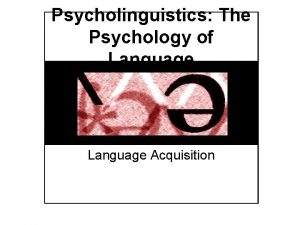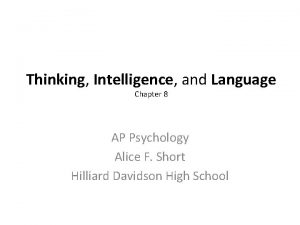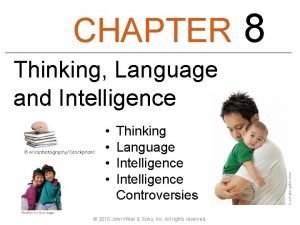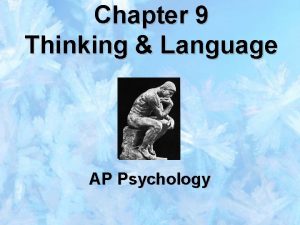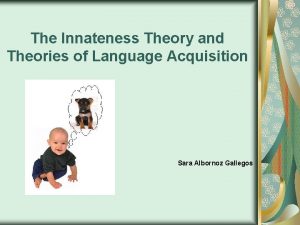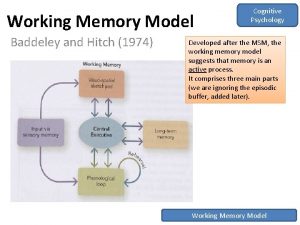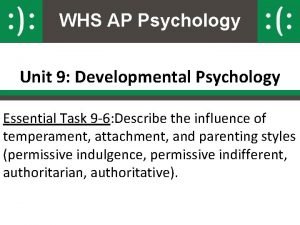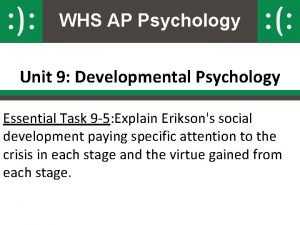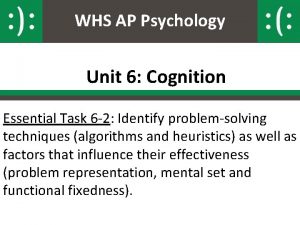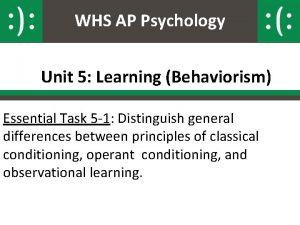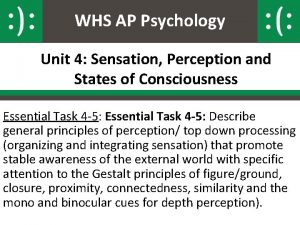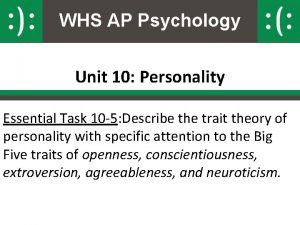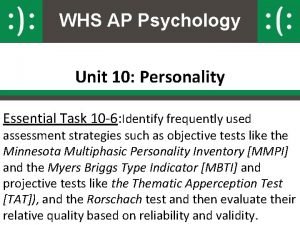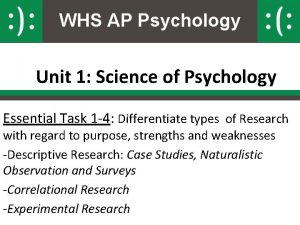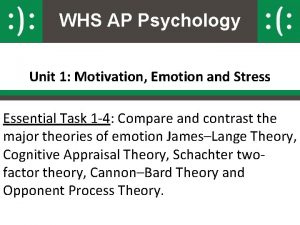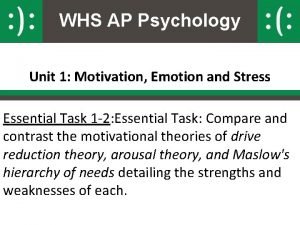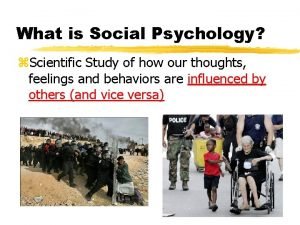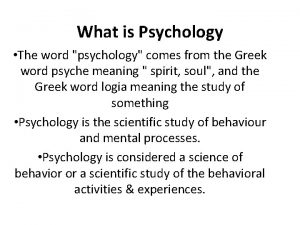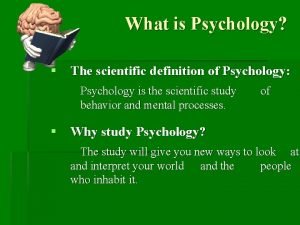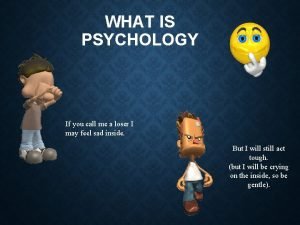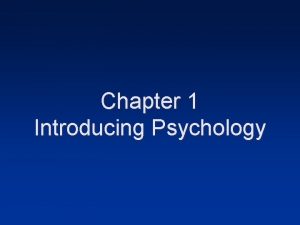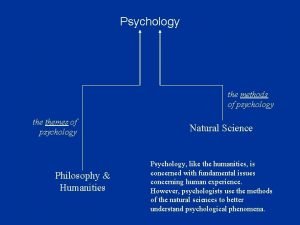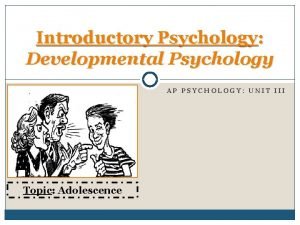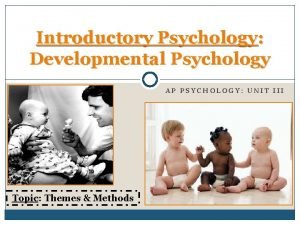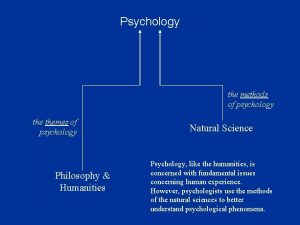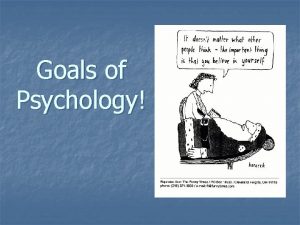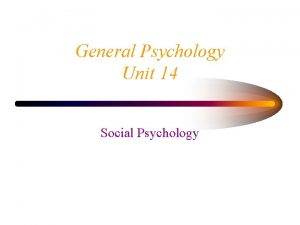Language AP Psychology What is Language n Language





























- Slides: 29

+ Language AP Psychology

+ What is Language? n Language -- how we combine spoken, written words as we think and communicate n Simply put, language is one of the most important characteristics of human behavior.

+ What Language Is: n Human language can convey meaning about: n The Past n The Present n The Future n Hypothetical Future n Because we can transcend time and space with language, we have an unlimited ability to communicate ideas.

+ What Language Isn’t n Gestures that we often use are not language n For example, waving hello is not really an act of language because the simple act of waving does not transcend time or space. n When I wave to someone, I wave to them “right now, ” not in an hour, not in a week, not yesterday.

+ What Language Isn’t n We have to leave out most animal communication because there are limits to what animals can communicate to each other. n When a dog barks, it is not an indication of some discomfort the animal had two weeks ago. n Rather, the animal is communicating that “right now” there is something in its world that is capturing the animal’s attention.

+ Structure n. Phonemes – smallest distinctive sound unit n For example, all the letters of the alphabet are phonemes n There is some overlap; n for example, c can make the k or the s sound— n a fact that children often struggle with.

+ Phonemes n All the letters in the alphabet are phonemes n Blends (such as ch, sh, th, etc. ) are also phonemes. n In English, we produce all the unique sounds that we are able to make by combining only about 40 to 50 unique phonemes. (between 40 and 50 because there is no universal agreement about this. ) n Other languages make do with less. For example, Hawaiian is often cited as a language that has less than 30 phonemes.

+ Structure n Morphemes – smallest unit that carries meaning n Many words are composed of a large variety of morphemes, which are all combined to produce a unique meaning. n Hint: “M” stands for morpheme and for meaning! n So, small words, such as dog or run are morphemes. n If we add the letter s to dog, we now have two morphemes (dog[s]), n and if we add ing to run, we now have two morphemes (runn[ing]).

+ Structure n Grammar – a system of rules that allows us to understand one another n Semantics – the study of meaning in language n Syntax – a set of rules for combining words in a sentence

+ Syntax--Rules for combining words in sentences n For example, in English, we typically place nouns or subjects first and verbs or predicates second n e. g. , We are going to the store. . n We can reverse the order, but we need to do so only in specific situations, such as when we want to ask a question n e. g. , Are we going to the store?

+ Let’s Practice n. Identifying Morphemes and Phonemes n. Complete part 2 #4 on the front, and all of

+ Language Development

+ Development of Language Video n Babbling stage n Begins around 4 months – make random noises of all n Around 10 months – babbles restricted to noise of home language

+ Development of Language n One-word stage n Around 12 months n word learning begin to explode around 18 months

+ Development of Language n Two-word stage (telegraphic speech) n Around 24 months n Follows rules of syntax n After age 2, children very quickly develop long phrases.

+ Development of Language

+ Development of Language n This pattern is not only predictable in English. n Other languages show the same pattern of language acquisition. n In addition, all children appear to babble the same way. n children make the same noises in all languages as they acquire language.

+ Development of Language n As a native language begins to emerge, sounds appropriate to that language are strengthened, and the inappropriate sounds (like babbling) drop out. n This explains why parents often believe that children are babbling in a foreign language!

+ Development of Language Predictions n Children can make predictions about language at about the same time. n For example, if children are told that they are looking at a “wug, ” and then are asked what one would say if there were two of these critters, they will say “wugs. ”

+ Development of Language n In addition, if they are told that a person will “wik, ” they will generate the forms “wiked” and “wiking. ” n Thus, they seem to learn the rules that they can then apply where appropriate.

+ Language Development n Overextension n Children in their second and third years sometimes use words as overextensions; n “doggie, ” for instance, may refer to a variety of four-legged animals as well as to dogs, n The word “daddy” may be used in reference to all men n This occurs simply because, although the infant detects the differences among various types of animals, he has only one word (“dog”). . .

+ Language Development n Overregularization: n Children extend regular grammatical patterns to irregular words, n such as the use of goed for went. n One of the first rules that English-speaking children apply is to add -s to form the plural. n Overregularization leads many young children to talk about foots, tooths, sheeps, and mouses. n They may even put the -s on adjectives when the adjectives are acting as nouns, as in this dinner-table exchange between my 3 -year-old and her father: n Sarah: I want somes. n Father: You want some what? n Sarah: I want some mores. n n Father: Some more what? Sarah: I want some more chickens.

+ Explaining Language Development Skinner/Behaviorist Approach – n language is learned like everything else with the principles of association, imitation, and reinforcement. n When we are reinforced, we repeat the behavior

+ Explaining Language Development Noam Chomsky – n Language (LAD) Acquisition Device n Children are pre-wired with a capability to learn language (innate). n The specific language is learned n The brain is like a languageacquisition device.

+ Language Acquisition Device n Language is learned through exposure to language n Interaction with environment allows that skill to emerge n There is a sensitive period of language acquisition n If we do not learn language during this time, we are not going to learn language well n Chomsky disagreed with the Behavioral Approaches n They do not take into account the problem that we learn language differently than we learn other things.

+ Animal thinking and language n. Do animals think? Yes. n Monkeys can count n Monkeys show insight n Apes use tools and learn from each other. n Apes pass the selfconcept test. n Apes can be deceptive

+ Animal thinking and language n Do Animals have Language? n Evidence for yes: n Honeybees – waggle dance n Washoe (a chimp) was taught sign language (181 signs) even put signs together in novel ways. n Others as well. n Spontaneous signing n Spontaneous learning

+ Animal thinking and language n Apes Don’t Have Language? n Not easy for apes n Maybe just making gestures for rewards? n Lack syntax. n Confirmation bias! n Koko—Doll n Koko-Love?

+ The Secret Language of Elephants
 Positive psychology ap psychology definition
Positive psychology ap psychology definition Group polarization psychology definition
Group polarization psychology definition Social psychology ap psychology
Social psychology ap psychology Introspection method in psychology
Introspection method in psychology Social psychology definition psychology
Social psychology definition psychology Health psychology definition ap psychology
Health psychology definition ap psychology Overextension in psychology
Overextension in psychology Is evaluating alternatives and making choices among them.
Is evaluating alternatives and making choices among them. Thinking, language and intelligence psychology summary
Thinking, language and intelligence psychology summary Statistical learning ap psychology
Statistical learning ap psychology Active construction of grammar theory
Active construction of grammar theory What is a working model psychology
What is a working model psychology Ap psychology unit 9
Ap psychology unit 9 Initiative vs guilt
Initiative vs guilt Practical intelligence ap psychology
Practical intelligence ap psychology Assimilation ap psychology definition
Assimilation ap psychology definition Metnal set
Metnal set Behaviorism ap psychology definition
Behaviorism ap psychology definition Color constancy ap psychology
Color constancy ap psychology Ethnocentrism ap psychology
Ethnocentrism ap psychology Unit 10 personality ap psychology
Unit 10 personality ap psychology Unit 10 personality ap psychology test
Unit 10 personality ap psychology test Ap psychology unit 1 test
Ap psychology unit 1 test Schachter's two factor theory
Schachter's two factor theory Drive reduction theory
Drive reduction theory Optimistic explanatory style ap psychology
Optimistic explanatory style ap psychology Social facilitation psychology
Social facilitation psychology Psychology comes from the greek word
Psychology comes from the greek word Evolutionary perspective of psychology
Evolutionary perspective of psychology Gestalt theory
Gestalt theory






